Journal of Southern Medical University ›› 2025, Vol. 45 ›› Issue (9): 1818-1829.doi: 10.12122/j.issn.1673-4254.2025.09.02
Hongyang WANG1,2( ), Wenyi ZHU1, Xushen CHEN1, Tong ZHANG1, Zhiwei CAO3, Jin WANG3, Bo XIE3, Qiang LIU2, Xuefeng REN1,3(
), Wenyi ZHU1, Xushen CHEN1, Tong ZHANG1, Zhiwei CAO3, Jin WANG3, Bo XIE3, Qiang LIU2, Xuefeng REN1,3( )
)
Received:2025-04-01
Online:2025-09-20
Published:2025-09-28
Contact:
Xuefeng REN
E-mail:wanghongyang0108@163.com;20231135@zcmu.edu.cn
Hongyang WANG, Wenyi ZHU, Xushen CHEN, Tong ZHANG, Zhiwei CAO, Jin WANG, Bo XIE, Qiang LIU, Xuefeng REN. Disrupting atherosclerotic plaque formation via the "qi meridian-blood channel": mechanism of Jiangzhi Huaban Decoction for regulating hepatic reverse cholesterol transport to improve atherosclerosis[J]. Journal of Southern Medical University, 2025, 45(9): 1818-1829.
Add to citation manager EndNote|Ris|BibTeX
URL: https://www.j-smu.com/EN/10.12122/j.issn.1673-4254.2025.09.02
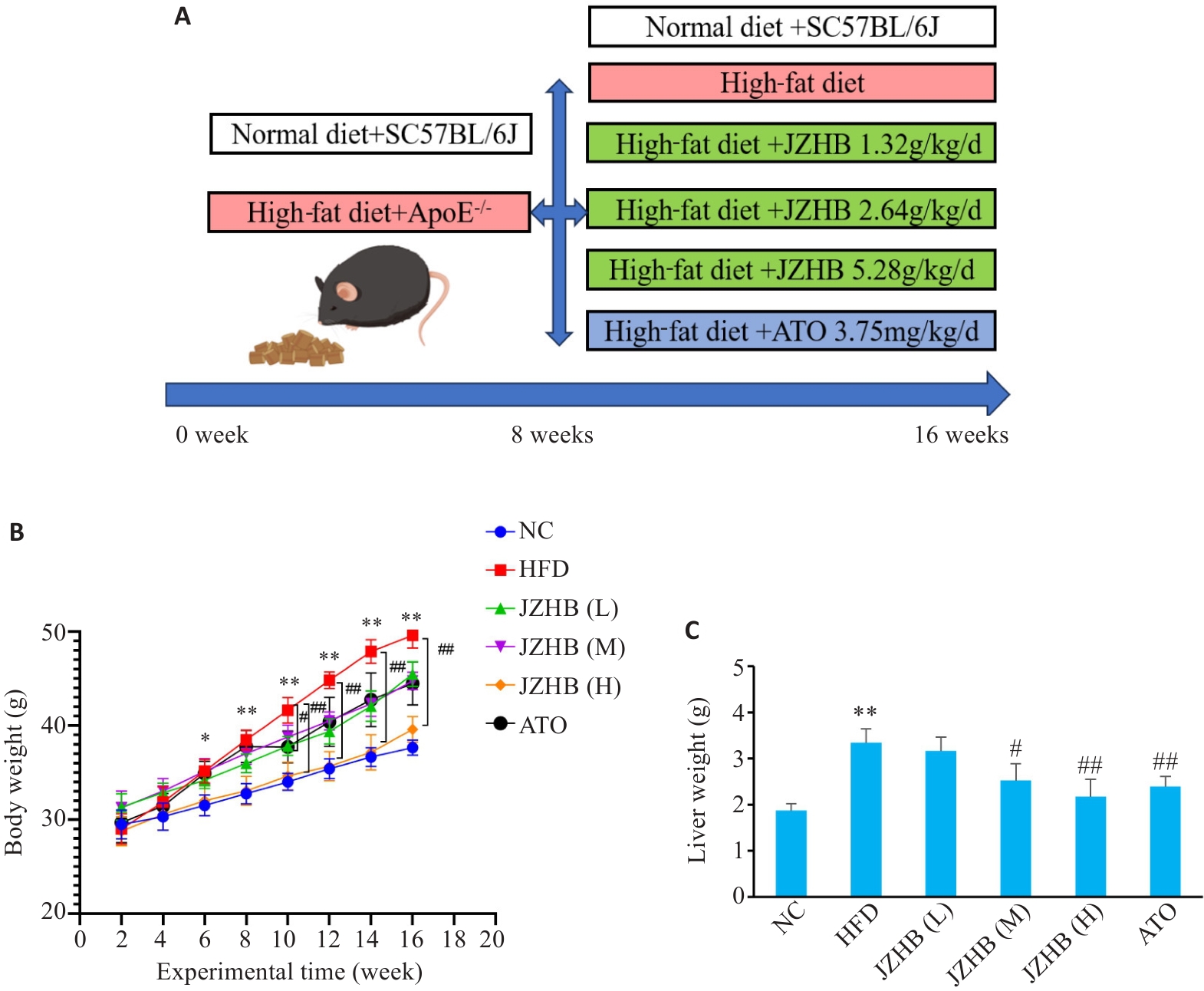
Fig.1 Drug intervention flowchart (A) and changes in body (B) and liver weight (C) of the mice during treatment. *P<0.05, **P<0.01 vs NC group; #P<0.05, ##P<0.01 vs HFD group.
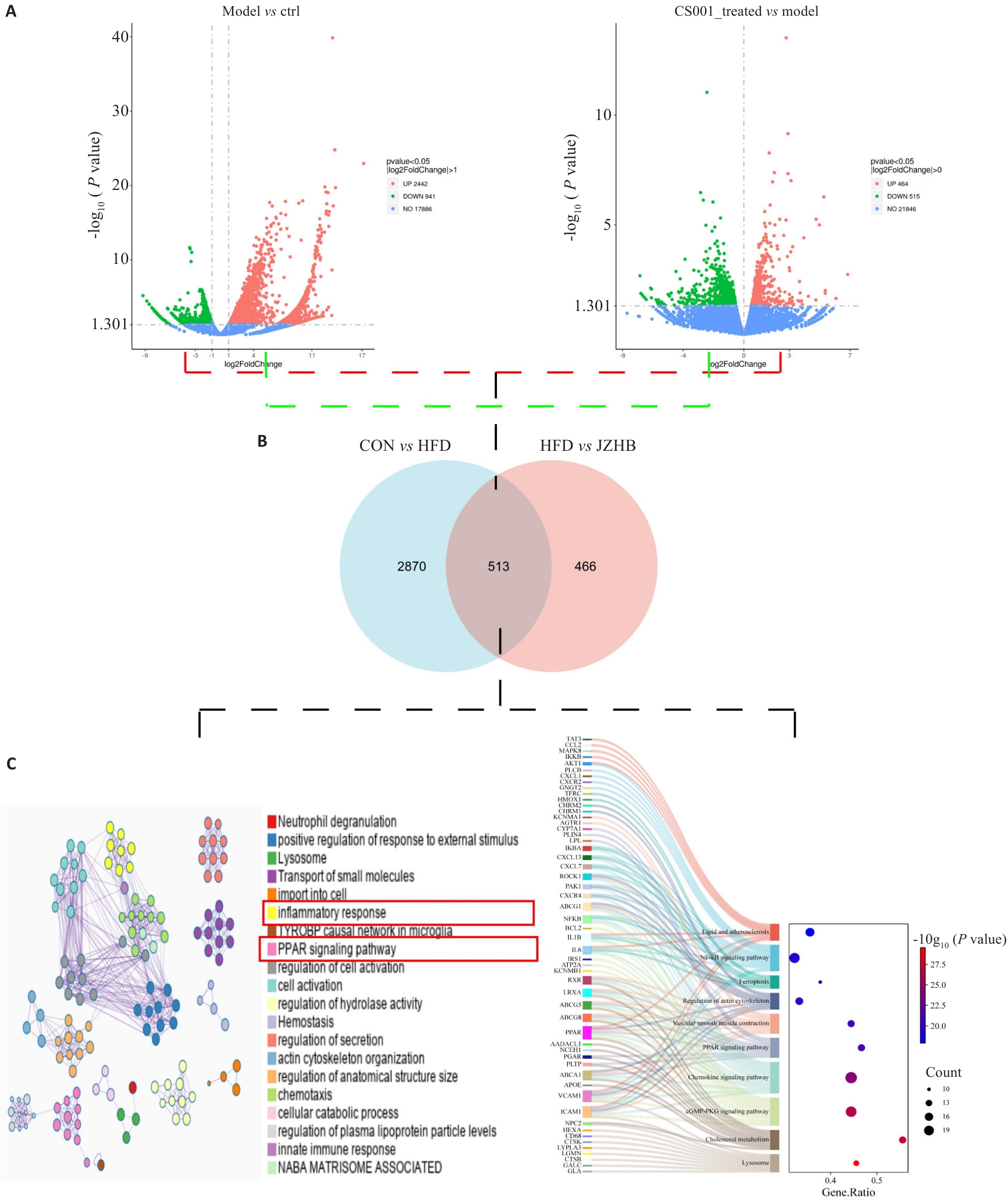
Fig.3 Analysis of differentially expressed genes (DEGs) in mouse aortic transcriptomics. A: Volcano plot of DEGs in HFD group vs control and JZHB groups. B: Venn diagram of reversal genes in HFD group vs control and JZHB groups. C: Modular functional clustering analysis of reversal genes and the visualization of the "key gene-pathway" relationships using Sankey-Bubble plot diagrams.
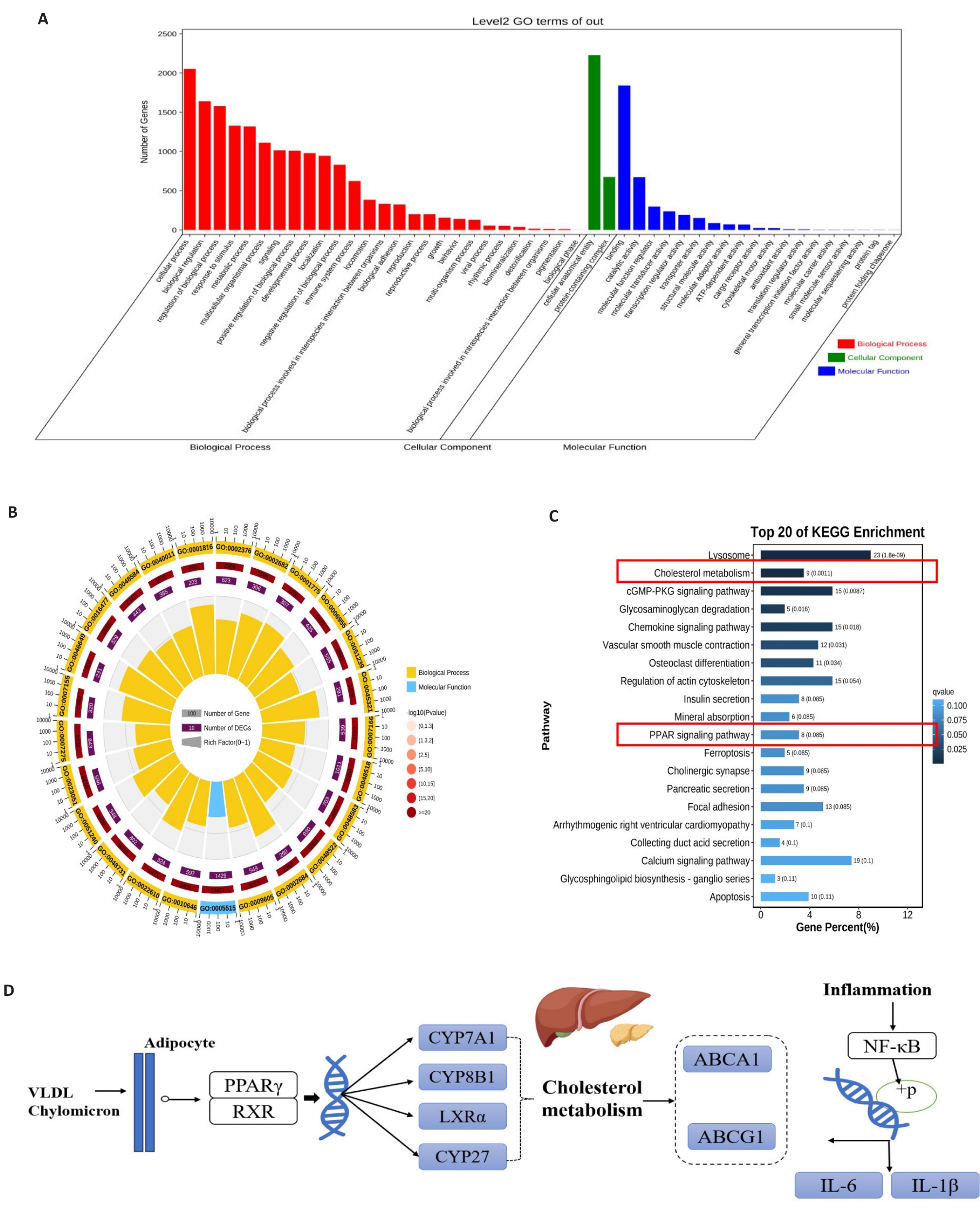
Fig.4 GO and KEGG functional enrichment analysis. A, B: GO functional enrichment analysis of JZHB against AS. C: KEGG pathway enrichment analysis of JZHB against AS. D: Schematic representation of the regulation of key targets of PPARγ/ LXRα/ NF-κB signaling pathway.
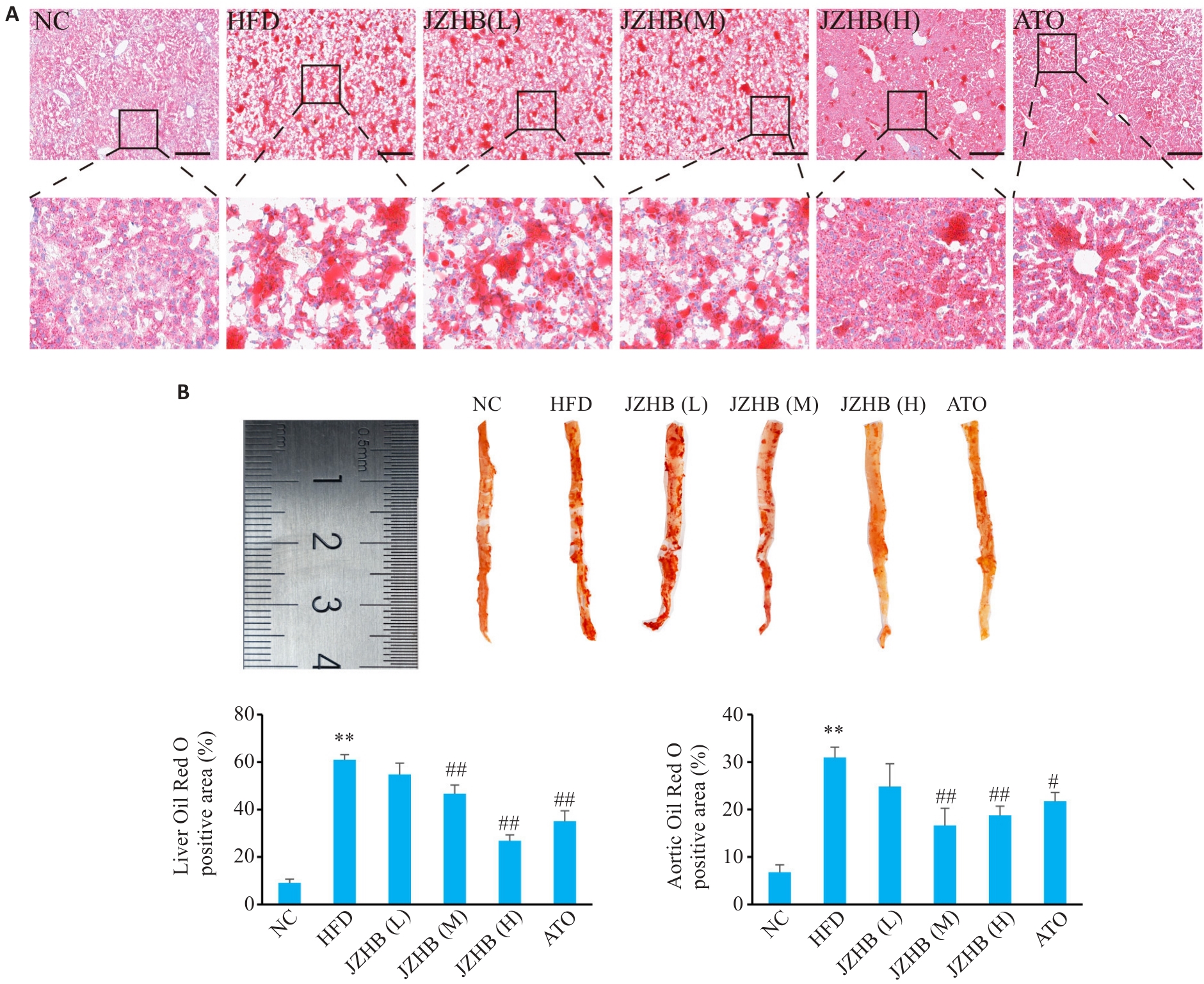
Fig.5 Pathological changes in the liver and aortic tissue of the mice in each group. A: Oil Red O staining of the liver tissues in each group (Original magnification: ×200). B: Oil Red O staining of the aortic tissue in each group. **P<0.01 vs NC group; #P<0.05, ##P<0.01 vs HFD group.
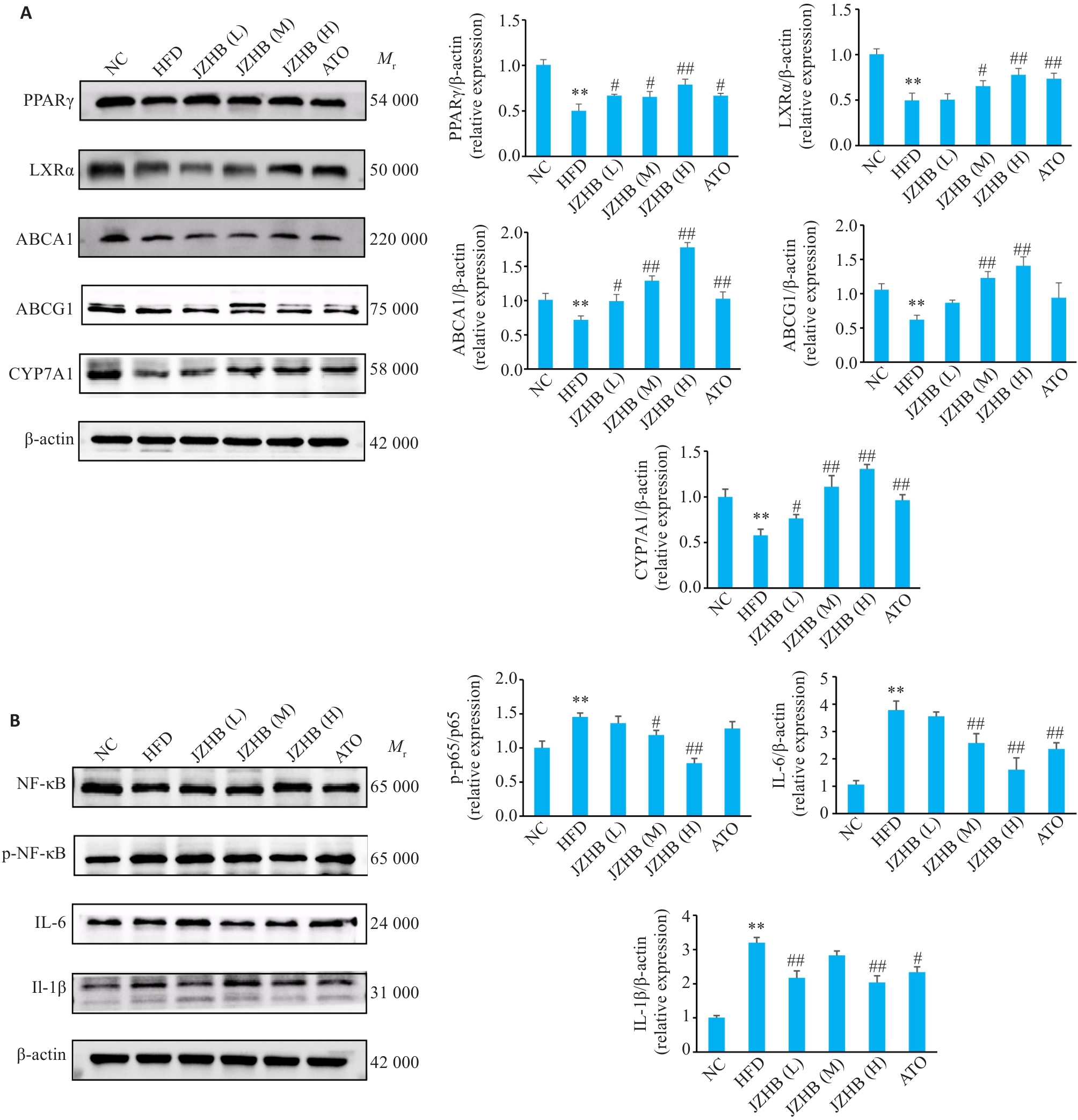
Fig.7 Changes of PPARγ/LXRα/NF-κB signaling pathway proteins in the liver of the mice in each group (Mean±SD, n=3). A: PPARγ, LXRα, ABCA1, ABCG1 and CYP7A1 protein expression in the livers of the mice. B: p65, p-p65, IL-6 and IL-1β protein expressions in the livers of the mice. **P<0.01 vs NC group; #P<0.05, ##P<0.01 vs HFD group.
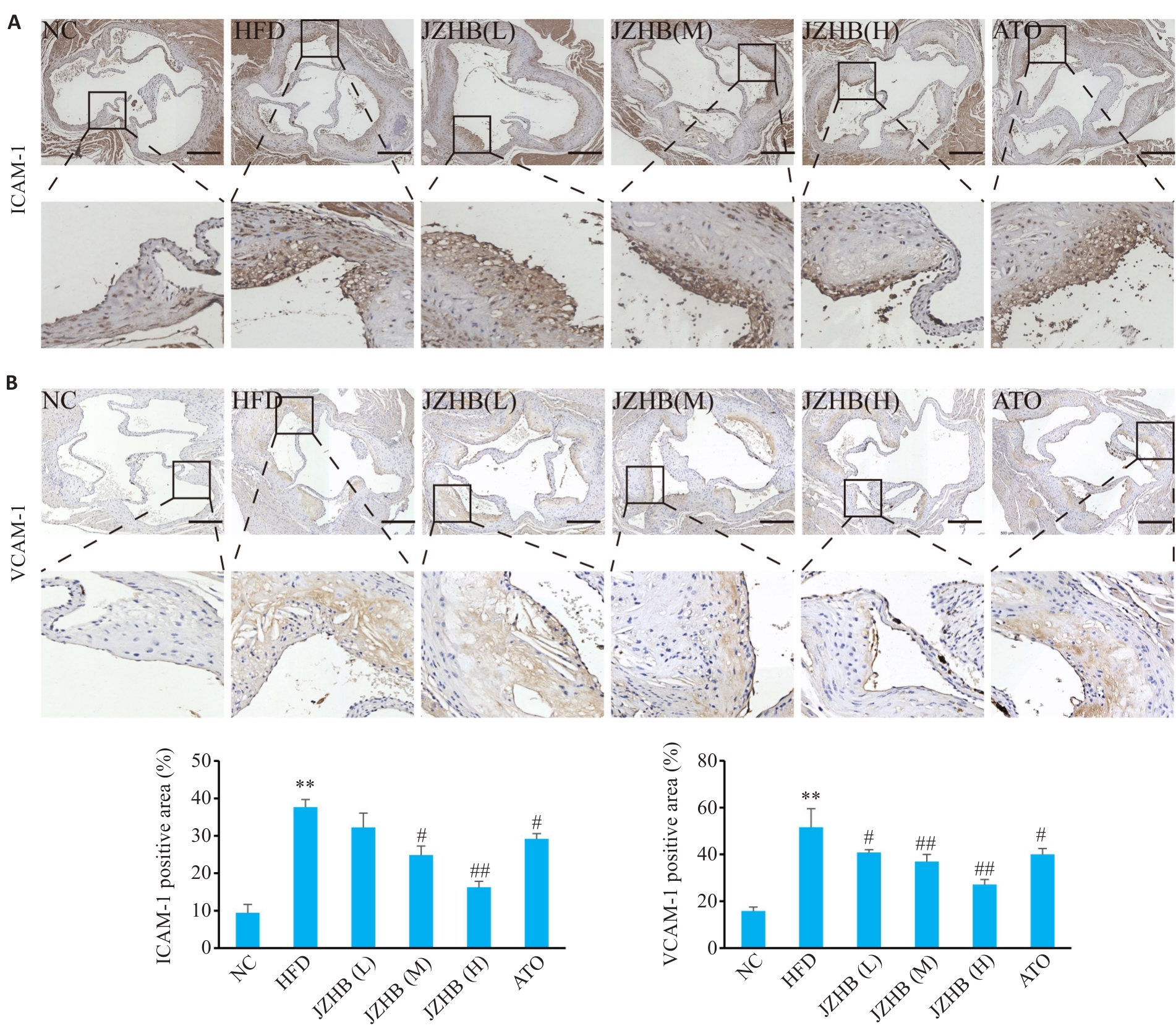
Fig.9 Immunohistochemistry for ICAM-1 (A) and VCAM-1 (B) proteins in aortic root plaques of the mice in each group (×100). **P<0.01 vs NC group, #P<0.05, ##P<0.01 vs HFD group.
| [1] | 刘明波, 何新叶, 杨晓红,等.《中国心血管健康与疾病报告2023》要点解读[J]. 中国心血管杂志, 2024, 29(4): 305-24. |
| [2] | Björkegren JLM, Lusis AJ. Atherosclerosis: recent developments[J]. Cell, 2022, 185(10): 1630-45. doi:10.1016/j.cell.2022.04.004 |
| [3] | Wesley UV, Bora R, Ricks K, et al. Abstract TP300: apolipoprotein-E deficiency and high fat diet alter immunomodulatory cellular and molecular determinants promoting atherosclerosis, a stroke risk factor[J]. Stroke, 2024, 55(): 236. doi:10.1161/str.55.suppl_1.tp300 |
| [4] | Walker ME, De Matteis R, Perretti M, et al. Resolvin T4 enhances macrophage cholesterol efflux to reduce vascular disease[J]. Nat Commun, 2024, 15(1): 975. doi:10.1038/s41467-024-44868-1 |
| [5] | 陈馨浓, 葛其卉, 赵一璇, 等. 从“脉中积” 认识动脉粥样硬化[J]. 中医杂志, 2022, 63(16): 1532-7. doi:10.13288/j.11-2166/r.2022.16.007 |
| [6] | Shi H, Sun M, Wang S, et al. Jiawei Dachaihu decoction protects against mitochondrial dysfunction in atherosclerosis (AS) mice with chronic unpredictable mild stress (CUMS) via SIRT1/PGC-1α/TFAM/LON signaling pathway[J]. J Ethnopharmacol, 2024, 330: 118150. doi:10.1016/j.jep.2024.118150 |
| [7] | 杨荣来, 王凤荣, 史海蛟, 等. 以“痰瘀毒”立论探讨大柴胡汤防治动脉粥样硬化的炎症反应[J].辽宁中医药大学学报, 2020, 22(8): 94-6. doi:10.13194/j.issn.1673-842x.2020.08.023 |
| [8] | 宋丽佳, 王 帅, 逯文蕊, 等. 基于“肠道微生物-线粒体轴”探讨中医药防治动脉粥样硬化的研究进展[J].时珍国医国药,2025, 36(4):734-43. |
| [9] | 佘一鸣, 胡永慧, 张莉野, 等. 中药调血脂的研究进展[J]. 中草药, 2017, 48(17): 3636-44. doi:10.7501/j.issn.0253-2670.2017.17.029 |
| [10] | Lee YS, Lee JM, Chung H, et al. Efficacy and safety of da-Chai-hu-Tang in lipid profiles in high-risk, statin-treated patients with residual HyperTG: a 12-week, randomized, active-control, open clinical study[J]. Life: Basel, 2022, 12(3): 408. doi:10.3390/life12030408 |
| [11] | 何剑平, 张 暋. 《黄帝内经》络脉理论与老年冠心病病机相关性探析[J]. 第一军医大学学报, 1999, 19(S1): 98-9. |
| [12] | 张福利, 刘海燕, 马伯艳, 等. 吴鞠通以“血络” 与“气经” 病位之异而制络病方心法述评[J]. 中华中医药学刊, 2009, 27(6): 1146-7. |
| [13] | Li X, Ge JD, Li YJ, et al. Integrative lipidomic and transcriptomic study unravels the therapeutic effects of saikosaponins A and D on non-alcoholic fatty liver disease[J]. Acta Pharm Sin B, 2021, 11(11): 3527-41. doi:10.1016/j.apsb.2021.03.018 |
| [14] | 吴若琳, 黄裕鸿, 王天琦, 等.野黄芩素通过促进胆固醇外流途径抑制巨噬细胞泡沫化的作用机制[J].中国药理学通报, 2023, 39(12):2266-73. |
| [15] | Cheng MY, Yue TX, Wang H, et al. Biomimetic nanoparticles co-deliver hirudin and lumbrukinase to ameliorate thrombus and inflammation for atherosclerosis therapy[J]. Asian J Pharm Sci, 2025, 20(1): 100990. doi:10.1016/j.ajps.2024.100990 |
| [16] | Zhong L, Sun J, Li S, et al. Scorch processing of rhubarb (Rheum tanguticum Maxim. ex Balf.) pyrolyzed anthraquinone glucosides into aglycones and improved the therapeutic effects on thromboinflammation via regulating the complement and coagulation cascades pathway[J]. J Ethnopharmacol, 2024, 333: 118475. doi:10.1016/j.jep.2024.118475 |
| [17] | 庞国明, 张 芳, 李 慧, 等. 基于“肝为丛病之脏” 论治内科杂病[J]. 中医杂志, 2023, 64(15): 1604-7, 1611. doi:10.13288/j.11-2166/r.2023.15.016 |
| [18] | Cirella A, Sinatti G, Bracci A, et al. Fully automated approach of machine learning combined with deep learning to forecast the coronary artery disease in patients with non-alcoholic fatty liver disease[J]. J Hepatol, 2023, 78: S685. doi:10.1016/s0168-8278(23)02052-4 |
| [19] | Ouimet M, Barrett TJ, Fisher EA. HDL and reverse cholesterol transport[J]. Circ Res, 2019, 124(10): 1505-18. doi:10.1161/circresaha.119.312617 |
| [20] | Miao M, Wang X, Liu T, et al. Targeting PPARs for therapy of atherosclerosis: a review[J]. Int J Biol Macromol, 2023, 242(pt 2): 125008. doi:10.1016/j.ijbiomac.2023.125008 |
| [21] | Wang SQ, Xiang J, Zhang GQ, et al. Essential oil from Fructus Alpinia zerumbet ameliorates atherosclerosis by activating PPARγ-LXRα-ABCA1/G1 signaling pathway[J]. Phytomedicine, 2024, 123: 155227. doi:10.1016/j.phymed.2023.155227 |
| [22] | Zhang DD, Song Y, Kong P, et al. Smooth muscle 22 alpha protein inhibits VSMC foam cell formation by supporting normal LXRα signaling, ameliorating atherosclerosis[J]. Cell Death Dis, 2021, 12(11): 982. doi:10.1038/s41419-021-04360-w |
| [23] | 王春雨, 成佳琳, 韩金华, 等.基于“阳化气, 阴成形”理论的代谢综合征发病机理微探[J]. 北京中医药大学学报, 2024, 47(9): 1217-22. |
| [24] | Wang H, Pan F, Liu J, et al. Huayuwendan decoction ameliorates inflammation via IL-17/NF‑κB signaling pathway in diabetic rats[J]. J Ethnopharmacol, 2024, 319(pt 3): 117328. doi:10.1016/j.jep.2023.117328 |
| [25] | 张珊苑, 蔡巧燕, 祁江晗, 等. 清心解瘀颗粒抗动脉粥样硬化的药效学及调控机制[J]. 南方医科大学学报, 2024, 44(8): 1518-28. |
| [26] | Bei YR, Zhang SC, Song Y, et al. EPSTI1 promotes monocyte adhesion to endothelial cells in vitro via upregulating VCAM-1 and ICAM-1 expression[J]. Acta Pharmacol Sin, 2023, 44(1): 71-80. doi:10.1038/s41401-022-00923-5 |
| [27] | Mathew DT, Peigh G, Lima JAC, et al. Associations of circulating vascular cell adhesion molecule-1 and intercellular adhesion molecule-1 with long-term cardiac function[J]. J Am Heart Assoc, 2024, 13(6): e032213. doi:10.1161/jaha.123.032213 |
| [28] | Madonna R, Barachini S, Ghelardoni S, et al. Vasostatins: new molecular targets for atherosclerosis, post-ischaemic angiogenesis, and arteriogenesis[J]. Cardiovasc Res, 2024, 120(2): 132-9. doi:10.1093/cvr/cvae008 |
| Viewed | ||||||
|
Full text |
|
|||||
|
Abstract |
|
|||||